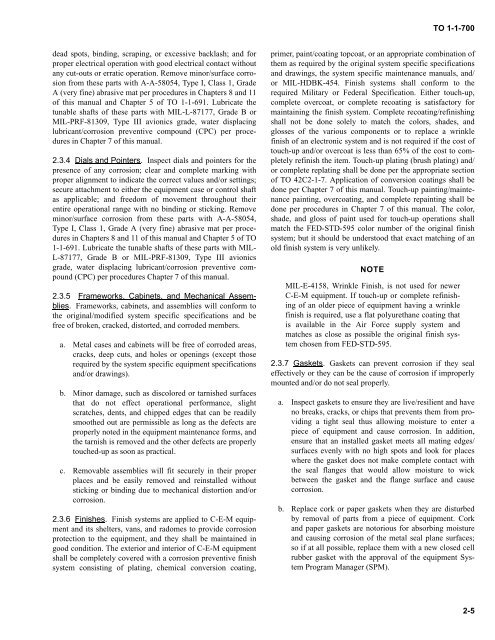TO 1-1-700 - Robins Air Force Base
TO 1-1-700 - Robins Air Force Base
TO 1-1-700 - Robins Air Force Base
Create successful ePaper yourself
Turn your PDF publications into a flip-book with our unique Google optimized e-Paper software.
<strong>TO</strong> 1-1-<strong>700</strong><br />
dead spots, binding, scraping, or excessive backlash; and for<br />
proper electrical operation with good electrical contact without<br />
any cut-outs or erratic operation. Remove minor/surface corrosion<br />
from these parts with A-A-58054, Type I, Class 1, Grade<br />
A (very fine) abrasive mat per procedures in Chapters 8 and 11<br />
of this manual and Chapter 5 of <strong>TO</strong> 1-1-691. Lubricate the<br />
tunable shafts of these parts with MIL-L-87177, Grade B or<br />
MIL-PRF-81309, Type III avionics grade, water displacing<br />
lubricant/corrosion preventive compound (CPC) per procedures<br />
in Chapter 7 of this manual.<br />
2.3.4 Dials and Pointers. Inspect dials and pointers for the<br />
presence of any corrosion; clear and complete marking with<br />
proper alignment to indicate the correct values and/or settings;<br />
secure attachment to either the equipment case or control shaft<br />
as applicable; and freedom of movement throughout their<br />
entire operational range with no binding or sticking. Remove<br />
minor/surface corrosion from these parts with A-A-58054,<br />
Type I, Class 1, Grade A (very fine) abrasive mat per procedures<br />
in Chapters 8 and 11 of this manual and Chapter 5 of <strong>TO</strong><br />
1-1-691. Lubricate the tunable shafts of these parts with MIL-<br />
L-87177, Grade B or MIL-PRF-81309, Type III avionics<br />
grade, water displacing lubricant/corrosion preventive compound<br />
(CPC) per procedures Chapter 7 of this manual.<br />
2.3.5 Frameworks, Cabinets, and Mechanical Assemblies.<br />
Frameworks, cabinets, and assemblies will conform to<br />
the original/modified system specific specifications and be<br />
free of broken, cracked, distorted, and corroded members.<br />
a. Metal cases and cabinets will be free of corroded areas,<br />
cracks, deep cuts, and holes or openings (except those<br />
required by the system specific equipment specifications<br />
and/or drawings).<br />
b. Minor damage, such as discolored or tarnished surfaces<br />
that do not effect operational performance, slight<br />
scratches, dents, and chipped edges that can be readily<br />
smoothed out are permissible as long as the defects are<br />
properly noted in the equipment maintenance forms, and<br />
the tarnish is removed and the other defects are properly<br />
touched-up as soon as practical.<br />
c. Removable assemblies will fit securely in their proper<br />
places and be easily removed and reinstalled without<br />
sticking or binding due to mechanical distortion and/or<br />
corrosion.<br />
2.3.6 Finishes. Finish systems are applied to C-E-M equipment<br />
and its shelters, vans, and radomes to provide corrosion<br />
protection to the equipment, and they shall be maintained in<br />
good condition. The exterior and interior of C-E-M equipment<br />
shall be completely covered with a corrosion preventive finish<br />
system consisting of plating, chemical conversion coating,<br />
primer, paint/coating topcoat, or an appropriate combination of<br />
them as required by the original system specific specifications<br />
and drawings, the system specific maintenance manuals, and/<br />
or MIL-HDBK-454. Finish systems shall conform to the<br />
required Military or Federal Specification. Either touch-up,<br />
complete overcoat, or complete recoating is satisfactory for<br />
maintaining the finish system. Complete recoating/refinishing<br />
shall not be done solely to match the colors, shades, and<br />
glosses of the various components or to replace a wrinkle<br />
finish of an electronic system and is not required if the cost of<br />
touch-up and/or overcoat is less than 65% of the cost to completely<br />
refinish the item. Touch-up plating (brush plating) and/<br />
or complete replating shall be done per the appropriate section<br />
of <strong>TO</strong> 42C2-1-7. Application of conversion coatings shall be<br />
done per Chapter 7 of this manual. Touch-up painting/maintenance<br />
painting, overcoating, and complete repainting shall be<br />
done per procedures in Chapter 7 of this manual. The color,<br />
shade, and gloss of paint used for touch-up operations shall<br />
match the FED-STD-595 color number of the original finish<br />
system; but it should be understood that exact matching of an<br />
old finish system is very unlikely.<br />
NOTE<br />
MIL-E-4158, Wrinkle Finish, is not used for newer<br />
C-E-M equipment. If touch-up or complete refinishing<br />
of an older piece of equipment having a wrinkle<br />
finish is required, use a flat polyurethane coating that<br />
is available in the <strong>Air</strong> <strong>Force</strong> supply system and<br />
matches as close as possible the original finish system<br />
chosen from FED-STD-595.<br />
2.3.7 Gaskets. Gaskets can prevent corrosion if they seal<br />
effectively or they can be the cause of corrosion if improperly<br />
mounted and/or do not seal properly.<br />
a. Inspect gaskets to ensure they are live/resilient and have<br />
no breaks, cracks, or chips that prevents them from providing<br />
a tight seal thus allowing moisture to enter a<br />
piece of equipment and cause corrosion. In addition,<br />
ensure that an installed gasket meets all mating edges/<br />
surfaces evenly with no high spots and look for places<br />
where the gasket does not make complete contact with<br />
the seal flanges that would allow moisture to wick<br />
between the gasket and the flange surface and cause<br />
corrosion.<br />
b. Replace cork or paper gaskets when they are disturbed<br />
by removal of parts from a piece of equipment. Cork<br />
and paper gaskets are notorious for absorbing moisture<br />
and causing corrosion of the metal seal plane surfaces;<br />
so if at all possible, replace them with a new closed cell<br />
rubber gasket with the approval of the equipment System<br />
Program Manager (SPM).<br />
2-5
















